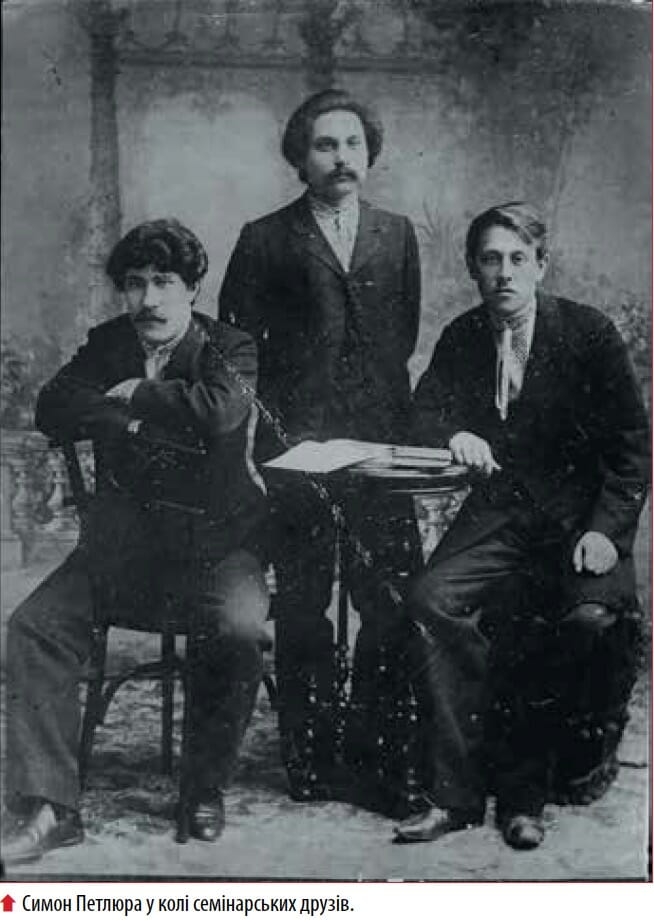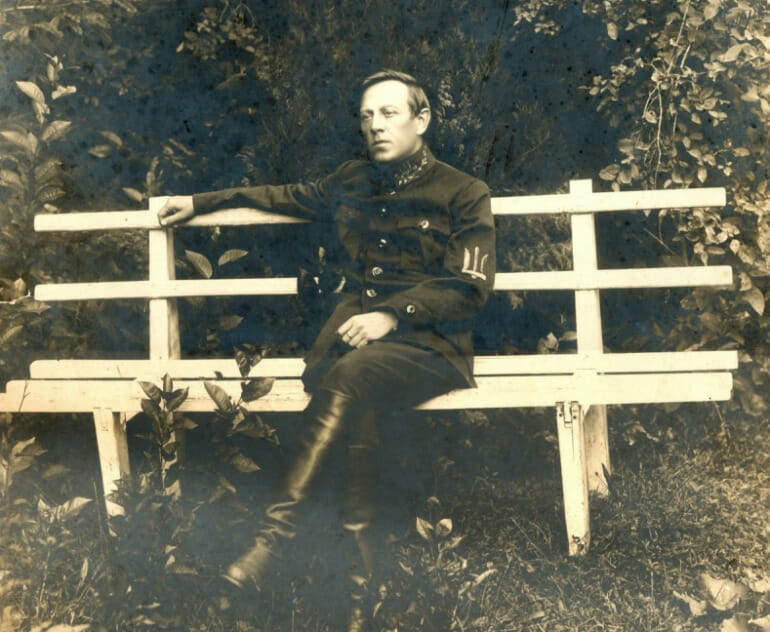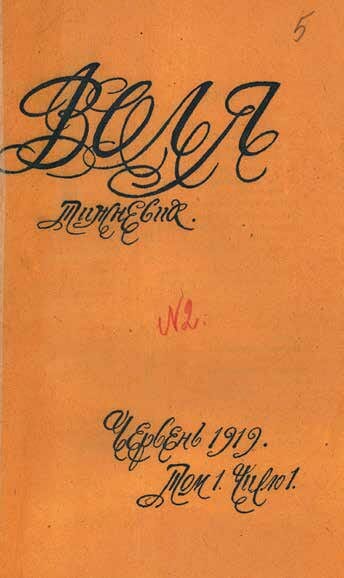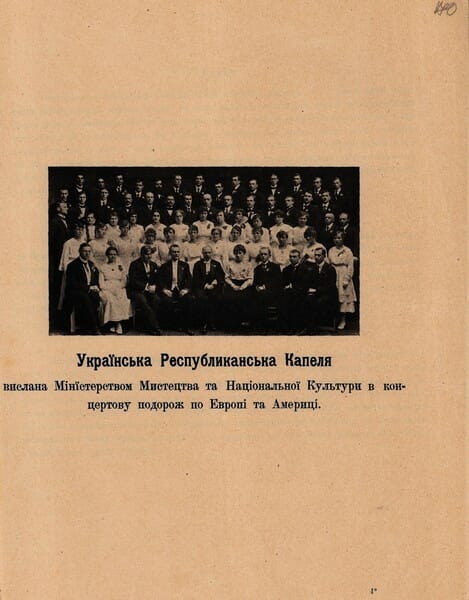For many of us Christmas is miracle and birth contemporarily. The Ukrainian Christmas carol Shchedryk was written by Mykola Leontovych and is considered cultural capital in Ukraine.
Seemingly simple, but really genius in its sound, it became the symbol of Christmas. Known in the world as Carol of the Bells, Shchedryk unites people and is recognizable from the first notes.
How did Shchedryk become the Carol of the Bells and why is it one of the most popular Christmas songs in America now? Why is this song called the beginning of “Ukrainian Spring”? How is Shchedryk related to Austria and the foundation of the Ukrainian state?
Interactive Ukrainian Vienna (www.iuv.guide) invites you to find out more about the foundation of the Ukrainian Republican Chapel, the finalization of Shchedryk and the Austrian Tour of the Republican Chapel at the World Tour at the beginning of 20th century.
***
Shchedryk’s story is a nearly century-long history of the formation of the Ukrainian state and the struggle for independence.
After the end of the First World War in 1918, the victorious countries at the Paris Peace Conference tried to agree on a new world order. In his famous 14 points, American President Woodrow Wilson enshrined the inalienable right of peoples to self-determination. Ukraine received hope for revival and a dream of an independent state. As a result, on January 22, 1918, the Ukrainian People’s Republic (UPR) proclaimed its independence.
At the same time, Russia continued to oppress and destroy Ukraine, spreading propaganda in Western countries that an independent Ukraine does not exist. The UPR government realized that the only chance to win the information war was to present Ukrainian culture to the world. Thus, Symon Petliura, Head of the Directorate, Chief Otaman of the UPR troops and navy, initiated the creation of the Chapel to counter Russian propaganda and promote Ukrainian culture and independence in Europe. The Chapel became a representative state institution of the UPR. The Chapel’s tours were supported by the Ministry of Education and Arts and the Ministry of Foreign Affairs of the UPR.
The tour program featured Mykola Leontovych’s “Shchedryk”, which made Ukrainian culture famous and raised Ukraine’s state prestige in 17 countries. The triumphant tour of the Ukrainian Republican Chapel under the baton of conductor Oleksandr Koshyts lasted from 1919 to 1924 in Western Europe, North and South America.

Law on the establishment of the Ukrainian Republican Chapel, 24.01.1919. © Central State Archive of Higher Government and Administration Bodies of Ukraine
Shchedryk – Symon Petliura and his way to the position of commander-in-chief
In Ukrainian history, there are two severe laws related to the ban on the spread of the Ukrainian language. The Valuyev Circular of 1863 and the Ems Decree of 1876 severely banned Ukrainian printing, including cultural and spiritual literature. Local theater performances were not allowed to be staged in Ukrainian, and the lyrics of Ukrainian songs were translated into Russian or French. The Ems decree remained in effect until 1905.
In 1901, 22-year-old Symon Petliura (then a final-year student at the Poltava Theological Seminary) met Mykola Lysenko, a prominent composer, promoter of Ukrainian music, and a public figure.
Despite the ban, Lysenko traveled around Ukraine with his choir, glorifying Ukrainian songs. “Lysenko’s musical wanderings inspired oppressed Ukrainians, but irritated the Russian authorities,” writes Tina Peresunko, the author of “Symon Petliura’s Cultural Diplomacy: ‘Shchedryk’ vs. the ‘Russian World’. The Mission of the Oleksandr Koshyts Chapel (1919-1924)”.
In the same book, Peresunko quotes an extract from Lysenko’s letter to the composer Filaret Kolessa, which reveals his intentions: “What a great need there is for a musician to wander among peasant folk, to acquaint himself with their worldview, to record their stories, memories, recollections, proverbs, songs, and chants. This whole sphere is as necessary for a man as air, and it is a sin for a musician and a philologist to begin work without it.“
Symon Petliura, delighted with his communication with Lysenko, organized a concert in the seminary’s auditorium and gave a speech. It was important for Petliura to hear Lysenko’s opinion of the choir’s performance under his leadership. As a result, an avid russophile, protopriest Ivan (Picheta), learned about the unauthorized concert. Petliura was expelled from the seminary, with the consequent impossibility of entering any university in Russia.

© Tina Peresunko: “Symon Petliura’s Cultural Diplomacy: ‘Shchedryk’ vs. the ‘Russian World’. The Mission of the Oleksandr Koshyts Chapel (1919-1924)”
Petliura then engaged in various activities: he gave private lessons as a history teacher, worked as an editor of the “Ukrainian Life” newspaper, as an art critic, and as a revolutionary. He organized strikes and demanded the introduction of Ukrainian studies. Fearing arrest in 1902, he traveled to Kuban to work as an ethnographer.
Petliura was always interested in Ukrainian culture and its role in the formation of Ukrainian civil society and statehood. In his article “On the Question of Cultural Creativity” (1912), he wonders why Ukrainians, who recognize themselves as a distinct group, do not actively participate in the cultural and national movement, have a dulled awareness of belonging and connection to their own nationality, and instead devote so much energy to creating “the cultural power of the Great Russian people.” This is rather a rhetorical question because he immediately provides an explanation. Given the difficult thorny historical path of Ukrainians, he says, “not only has there been an attraction to where the culture is stronger, but also a distrustful attitude toward the potential forces of the Ukrainian people, their ability to pave an original cultural path. Hence, this group lacks a criterion for evaluating the cultural achievements that the Ukrainian people have already created amid the difficult circumstances of their historical hardships and continue to create today.”
During the First World War, Petliura was concerned with creating a capable Ukrainian army. His roles at different times: Chairman of the Ukrainian Front Council of the Western Front (1917); Secretary General of Military Affairs under the Central Rada (1917); Organizer and commander of the volunteer units of the Haydamak Kosh of Sloboda Ukraine (distinguished themselves in the defense of Kyiv from the Bolshevik January Uprising of 1918); Chief Otaman of the Army and Navy of the Ukrainian People’s Republic (1918-1926).
“Support the cowardly, persuade the uncertain, set an example. All of us are united by love for our native Ukraine and the desire to defend the revolution.” Tina Peresunko quotes this address by Petliura to Ukrainian soldiers (in his role as Secretary General of Military Affairs of the Central Rada) in her book “Symon Petliura’s Cultural Diplomacy: ‘Shchedryk’ vs. the ‘Russian World’. The Mission of the Oleksandr Koshyts Chapel (1919-1924)”.
Petliura called on parties and organizations to engage in education, because “an intelligent book written in a clear language will have a great cultural and educational impact on our countrymen at the front and establish a spiritual connection between them and us” (1917).

Symon Petliura ©uinp.gov.ua
The backstory to the creation of “Shchedryk”
On January 1, 1919, Symon Petliura, as the Chief Otaman of the Ukrainian People’s Republic (UPR), visited the Molodyy Theatre in Kyiv. The 25th anniversary of the creative activity of the poet and playwright Mykola Voronyi was being celebrated there. The program of the event included performances of “Zironka Vechirnia” and “Legend” as well as music by Mykola Leontovych. The latter impressed Symon Petliura so much that it inspired him to create the Ukrainian Republican Chapel and send it to Western Europe to promote Ukrainian culture. The chapel was intended to become a new asset in the struggle for independence.
And so, the next day, on January 2, 1919, the Commander-in-Chief issued an order to the heads of the Music Department of the Ministry of Public Education and Arts of the Ukrainian People’s Republic, Kyrylo Stetsenko and Oleksandr Koshyts: “In a week, prepare the Chapel for a tour abroad!” (From the book “Symon Petliura’s Cultural Diplomacy: ‘Shchedryk’ vs. the ‘Russian World’. The Mission of the Oleksandr Koshyts Chapel (1919-1924)).
A week later, a draft law on the Chapel was created, and three weeks later it was adopted by the National Council of Ministers.
Five months later, on May 11, 1919, the European premiere of the famous Shchedryk took place at the National Theater in Prague, and with it the first presentation of Ukraine’s musical and diplomatic mission on the world stage.
The Austrian tour of the Ukrainian Republican Chapel and Shchedryk
The Austrian tour of the Ukrainian Republican Chapel lasted from July 20 to October 8, 1919. It was much longer and more productive than the participants expected. During this time, the Chapel gave 11 concerts in the Wiener Konzerthaus, in the Great Hall, also known as Golden Hall of the Wiener Musikverein (Großer Saal), the Kurhaus Baden, a famous spa town 30 kilometers from the Austrian capital, and the Stadttheater Innsbruck. In addition, the Chapel gave many private concerts, including charity fundraisers to help Austrian youth. For this, it received special thanks from the city authorities.
More than 70 reviews were published in the local press in German and Ukrainian. We can read about the enormously enthusiastic and positive reviews of the Chapel’s performance in such well-known publications as: Neues Wiener Journal, Neue Freie Presse, Der Neue Tag, Neues Wiener Tagblatt, Die Zeit, Reichspost, Deutsches Voksblatt, Wiener Allgemeine Zeitung, Wiener Mittagspost, Die Arbeiter-Zeitung, Wiener Morgenzeitung, Neues Montagblatt, Wiener Mittag-Zeitung, Musica Divina, Badener Zeitung, Kunst und Leben, Badener Volksblatt, Delniskie listy, Wiener Joun und Montags Zeitung, Volks-Zeitung, Der Morgen, Der Merker, as well as Ukrainian‑language papers like: Na Perelomi, Smikh, Ukrainian Flag (Ukrayinskyi prapor), Volia.
The cover of the Ukrainian newspaper “Volia”, which published articles about the Chapel’s European tour.

© Central State Archive of Higher Government and Administration Bodies of Ukraine F.3965. Op.2. Issue 56. Sheet. 5
Ukrainian Republican Chapel and Shchedryk – Austrian tour and first impressions
The Ukrainian Republican Chapel arrived in Vienna on July 20, 1919.
After a jubilant Prague celebrating its independence, Vienna greeted the members of the Chapel with sadness and a “funereal mood,” as the Chapel’s courier and singer Alexander Pelensky wrote in his memoirs. “Vienna, this Vienna of Haydn, Beethoven, Mozart, and Strauss, responded to our song despite the dead season and the terrible mental depression. The Viennese realized that our song came from across the Dnipro not to amuse and entertain them and thus offend their national feelings and mourning, but to tell them about our pains and sorrows.”

Part of a brochure with the songs and program of the Chapel in Vienna. July 21-25, 1919. © Central State Archive of Higher Government and Administration Bodies of Ukraine. F.3965. Op. 1. Issue 5. Sheet 170
Two days later, on July 22, 1919, the Ukrainian Republican Chapel premiered at the Wiener Konzerthaus.
The representation of the Ukrainian Foreign Ministry in Vienna at the time (located in the Hotel Bristol) welcomed the mission from Ukraine with joy. The Ukrainian ambassador and prominent historian Vyacheslav Lypynsky attended the opening performance of the Chapel. Two days later, Foreign Minister Volodymyr Temnytsky, as well as the former head of the UPR Directorate, Volodymyr Vynnychenko, were also present at the concert (Vynnychenko’s signature was the first to appear on the law establishing the Chapel).
A week after arrival the Chapel’s schedule was still going strong. The concerts continued.
In Prague, the Chapel’s premiere performances took place at the highest level. Ambassador Slavinsky then initiated the practice of diplomatic receptions in honor of the artistic mission of the Ukrainian People’s Republic. Vienna adopted this practice, and on July 26, 1919, the Ukrainian embassy in Vienna organized a diplomatic reception, as this event is now called. At the reception, poet and cultural attaché Oleksandr Oles recited the improvised poem “‘Tis a dream again…”
The Chapel gave a special concert for Ukrainian prisoners of war. The editorial staff of the Ukrainian magazine “Volia” (which had been meeting for some time in Vienna’s Cafe Central), led by publicist Viktor Pisnyachevsky, hosted the Chapel. The Chapel’s concerts raised funds for the development of Vienna, and the Austrian Ministry of Social Welfare expressed its gratitude to the Chapel for its donations to the needs of Austrian youth.
The documents for the Chapel’s departure to France were delayed, and the musicians eventually stayed in Vienna for two more months. It was here that they first received a letter of support and admiration from Symon Petliura’s “patron”. He emphasized that he had heard a lot of positive feedback and applause about the Chapel’s performance, for which he was extremely grateful. He also wrote about the important mission and hard work accomplished by the singers, which “will be recorded in the pages of the history of the construction of our state and culture.”
However, the Chapel was faced with financial difficulties, but thanks to the support of the Ukrainian Embassy and the Ukrainian cooperative union “Dniprosoyuz”, they soon continued their concert tour.
The Ukrainian Republican Chapel and Shchedryk – Austrian tour and press reviews
The chapel gave a wide variety of concerts, all of which were crowned with success and incredible reception. The audience was shocked by the beauty of Ukrainian songs, and the Viennese press could not understand why nothing had been heard about a country with such a powerful culture. The Austrian press referred to the Chapel’s concerts as a meeting place between the West and the East, and to the UPR’s cultural mission as an international postwar emissary (ambassador).
Many reviews praised the singers for their skillful performance of beautiful works.
“Rarely have I had the chance to hear a choir with such harmony and completeness in sound, intonation, rhythm and dynamics. Not to mention the Ukrainian folk songs in such masterful arrangement and your unique conducting!” reads an enthusiastic letter from Ferdinand Löwe, director of the Vienna Music Academy, to the conductor of the Chapel, Oleksandr Koshyts.
It’s fascinating to read the conductor’s notes in his diaries: “The success was extraordinary. I was terribly afraid, because these were our first concerts in the true Europe and at the same time in its greatest musical city. But God helped us to accomplish this task in the best way possible. The critical response was wonderful. It struggled to find enough words of praise.”
On July 23, 1919, the “Deutsches Volksblatt” ran the headline “All the love, melancholy, and depth of Ukraine found its expression in these songs.” The review speaks of admiring the Ukrainian treasure in the form of song, which appeared in all its beauty and brilliance. “Religious, festive, and love songs that have been passed down from generation to generation show the national character of an emotionally deep nation that so sweetly fills the mind and soul of the listener.”
The “Wiener Mittagspost” of July 24, 1919, talks about the joyful guests – the Ukrainian Republican Chapel and its role: “The first fragile threads of armistice between lands and seas are attempted to be strung by art. That is why we welcome these dear guests with double cordiality for finding their way to us and bringing with them true great art. Rhythmic precision and rich colorful nuances, as well as dynamic shadowing – all this is the work of the choir’s conductor, Mr. Koshyts, who puts our guests in the first rows among the choirs.”
On July 26, 1919, “Neue Freie Presse” published a review entitled “Ukrainian Art Opposes Russian Sadness with Cheerfulness and Optimism”: “Ukraine, which has become politically independent, has established a ministry of culture, in which the music department is engaged in collecting ethnographic musical materials, publishing folk songs, and supporting choir associations, especially the ‘Ukrainian National Choir’, an organization that is essentially a means of political propaganda… Ukrainian art has long been opposed to the dark, devotional sadness of the Russians by cheerfulness, optimism, and the richness of freedom-loving dreaminess… Those who know the pure acapella sound will enjoy this Ukrainian art.”
The “Wiener Morgenzeitung” of July 27, 1919, wrote that the concert was a place where “the West opened its soul to the East. Ukrainians showed Vienna something amazing, and the program material may be of ethnographic interest. And the iron discipline and methodology contributed to a huge musical success, which is not always seen even in such a musical city as Vienna”, reads the review. “A group that can achieve such enormous success must have great strength of artistic individuality, or it must draw its strength from a powerful source of developed national art.”
“The Neues Montagblatt” of July 28, 1919, emphasized the high musical style, excellent understanding of sound, special mastery of conducting by Oleksandr Koshyts, and the poetic performance and music of Oleksandr Koshyts, Mykola Leontovych, Vasyl Stupnytsky, Kyrylo Stetsenko, and Mykola Lysenko. “This is nature and musical heritage that has come to us, who are satiated with modern culture.”
The publication of “Musica Divina” from August 7, 1919, concluded the success and actual achievement of the goal of the cultural mission in Vienna: “The Ukrainian Ministry of Culture and Arts focused its activities in the young state on choral singing as a means of political propaganda. The world, which has been intentionally negatively informed by despotic Russia about Ukraine, should be convinced of the originality of the culture of the Ukrainian people. Cultural maturity should become a legitimization for the world of the political independence of this country. […] The internal organization of the choir has strong democratic principles. The association is headed by the choir’s council, and a special committee looks after the legal and economic interests of the choir. All of them create something like a family, serving the political ideals of their homeland with their art.”
References:
- Головне фото: Українська Республіканська Капела 1922-1924 (с)ЦДАВО України. Ф.3965. Оп.2. Спр.49. Арк.1
- Пересунько Тіна. Культурна дипломатія Симона Петлюри: «Щедрик» проти «русского мира». Місія Капели Олександра Кошиця (1919–1924). Київ. Видавничий дім «АртЕк», 2019. 312 с.
- Матеріал з Вікіпедії — вільної енциклопедії, Щедрик / Shchedryk.
- Shchedryk / Щедрик. Carol of the Bells. Original Ukrainian Version with English and Ukrainian Lyrics [Архівовано 30 січня 2022 у Wayback Machine.], 20 грудня 2020.
- Ukrainian Institute. The Story of “Carol of the Bells”: Celebrating 100 Years of “Shchedryk” in New York, 4 грудня 2022.
- Kyiv Post. The Ukrainian story behind Carol of the Bells, 4.12.2022.
- Ronald Clancy. The Captivating Story about “Carol of the Bells”, 4.12.2022.
- “Ваша праця буде записана на сторінках історії…” До 100-річчя тріумфального закордонного турне Української Республіканської Капели під орудою Олександра Кошиця, Центральний державний архів вищих органів влади та управління України, tsdavo.gov.ua, /
- Harriman Institute, Columbia University. The Enduring Resonance of Carol of the Bells: Ukrainian Origins and Musical Contexts. Hybrid event, 30 November 2022.
- Leah Batsone. Ukraine’s Avantgarde: A Short History of a Long Tradition, AMS Nusicology Now, 21 November 2022.
